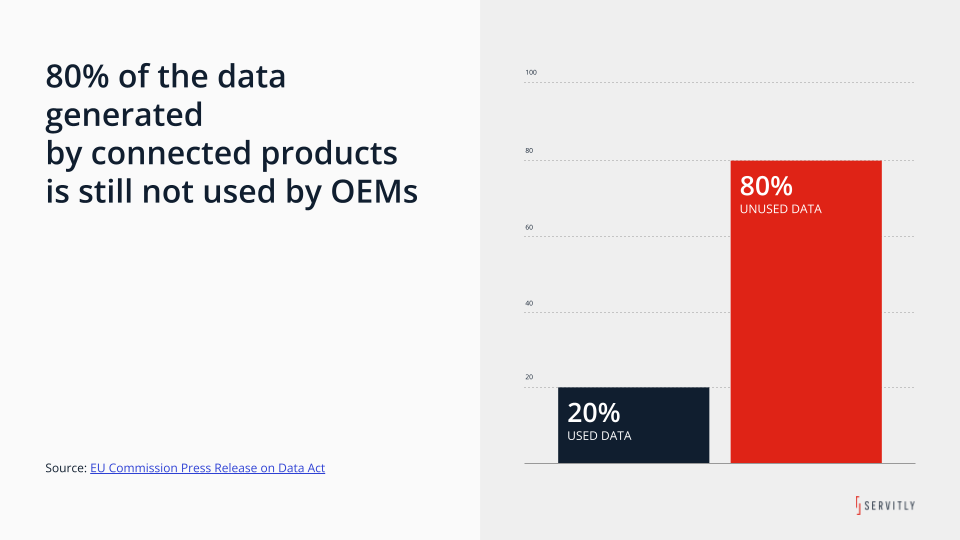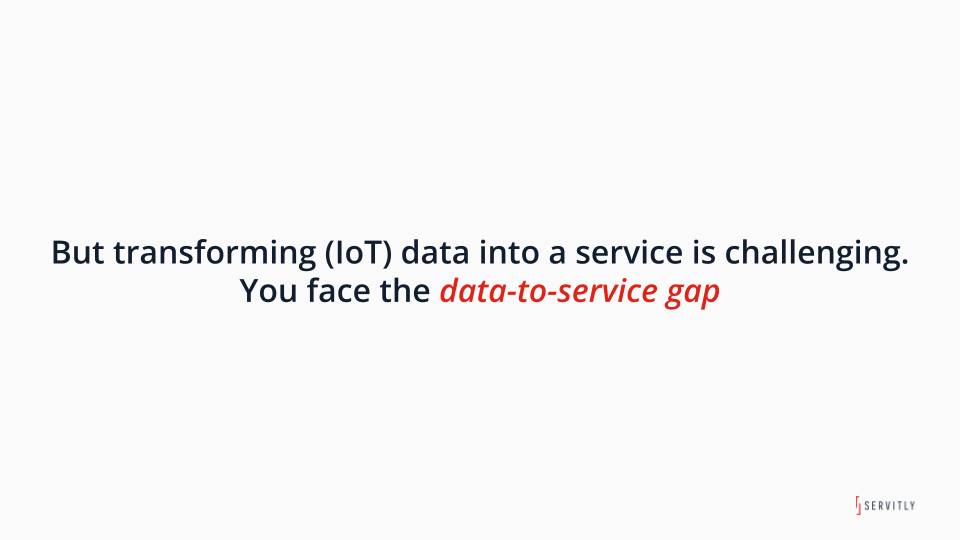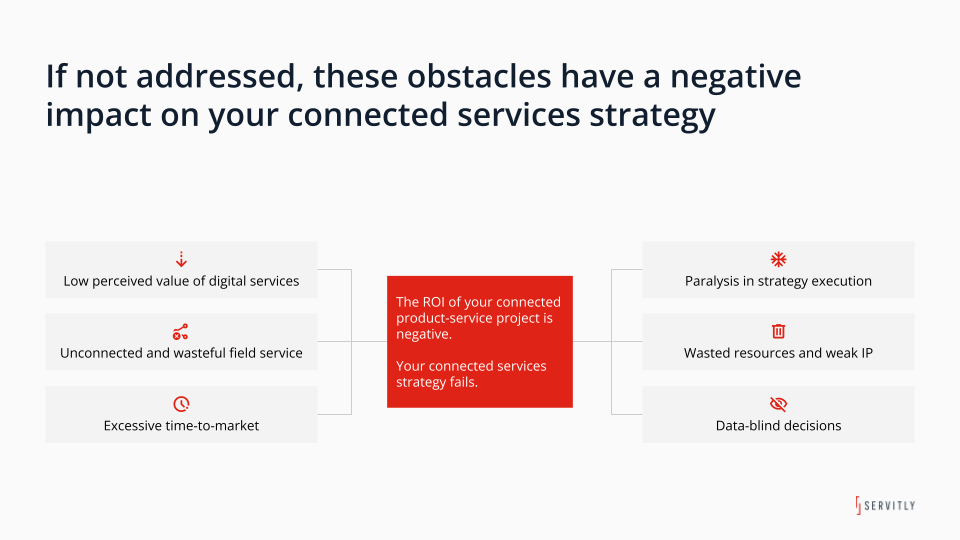Bridging the Data-to-Service Gap
Today, after 10 years of massive diffusion of IoT technologies, most new equipment (consumer, professional or industrial) is designed by its manufacturer to be connected.
In Europe alone, an estimated 1.5 billion connected products are currently in use.
Manufacturers/OEMs have invested significant resources, first to make their products connected and then to try to leverage the data received to offer value to their customers.
Enormous untapped potential
However, despite all the efforts and investments, today we see a failure of these initiatives. The European Commission indeed estimates that 80% of the data generated by connected products and collected by OEMs is not used.

The change in perspective: moving towards connected services
So how can an OEM "use" data received from its connected products?
Apart from internal use for the purpose of improving product design, the only other way to use them is to offer added value externally.
And this use can take only one form: that of a service, a data-based service or, as we prefer to call it, a “connected service”.
This change in perspective is fundamental: selling connected products is not enough; we can only keep the “promise” of the IoT by moving towards connected services.
How to transform data into a service
In how many ways can data be transformed into a service? How many possible types of connected services are there?
To answer these questions we analysed over 300 cases and interacted with the most authoritative research institutes on servitization. We then mapped all possible use cases for connected services, that is, all possible ways to exploit data to deliver value in the form of services.
In other words: how to transform data into a service.

"Using" data received from connected products means starting at least one of these 5 initiatives:
- Compose, deliver and sell digital services to end customers, such as capabilities for remote monitoring and control, performance analysis and advisory, aided maintenance
- Making field service connected and smarter for OEMs and their partners, i.e. leveraging connected product data to optimize after-sales activities, reduce risks and increase the outcomes and value of service contracts
- Simplify and automate the sale of spare parts and consumables, taking into account actual usage and product condition
- Evolving towards advanced data-driven services, such as outcome-based, performance-based, XaaS or pay-per-use contracts
- Share and monetize data with third parties interested in offering other types of services (from 12 September 2025, this is also required by the European Data Act)
(learn more about this topic in the Learning Center: https://learn.servitly.com/docs/how-to-design-a-connected-services-strategy)
The data-to-service gap
However, despite the technologies and solutions available today (such as IoT platforms or BI and data analytics platforms), using data to deliver even one of the connected service initiatives is far from simple. There is a huge gap between theory and practice.
Today, many companies that have begun this transformation towards connected services, while confirming their commitment in their choice, also highlight difficulties and challenges.
We can summarise them all in the term “data-to-service gap”.

The data-to-service gap is the combination of challenges, problems and limitations that companies face when attempting to transform data received from connected products into data-driven services (or “‘connected services”) that are genuinely valuable to end customers
The data-to-service Gap is is the reason why 80% of data remains unused.
The 6 main roadblocks
Since our foundation, we have been focusing on analysing and understanding this gap. We have identified the six main roadblocks that constitute it.
Ineffective data processing
Very often, data is not processed, but is simply presented in raw form within dashboards. The negative consequence of this limitation is that users struggle to find useful information and understand what they need to do.
Generic and product-driven UI
Usually, for the sake of simplicity, the same interface is offered to all users, with the only difference being data segregation; the interface is designed solely as an extension of the product's HMI. The downside of this limitation is that users do not receive any specific help for their needs, goals or tasks.
Hard-coded inflexible solution
Almost always, all the logic and interfaces are embedded directly in the source code of a custom solution, without any abstraction layer. The negative consequence of this limitation is that changes and upgrades to the solution are complex and expensive.
No integrated business functions
Typically, the solution only deals with presenting data and does not include any functions to support workflows and business processes, such as managing tickets and work orders, spare parts orders, subscriptions, maintenance activity logs, etc. The negative consequence of this limitation is a low value for the user and a fragmented experience across different solutions.
Ineffective mgt of different products
It is quite complex to adapt the logic and interface of a solution to different product types and families. The negative consequences of this limitation are logic and interfaces that are too generic, and therefore ineffective, or the duplication of the solution for different product types.
System isolation
Often, the solution is not designed for integration, either internally or externally, i.e. with the information systems of customers and partners. The negative consequences of this limitation are the misalignment of internal systems and the risk of rejection of the solution by customers and partners.
The symptoms of the gap
If not addressed, these obstacles have a negative impact on your connected services strategy and lead to the following symptoms:
- Low perceived value of digital services - the value of digital services perceived by customers is low; adoption and frequency of use is low and, if there are paid options, few are willing to pay
- Unconnected and wasteful field service - your field service still operates in the "old fashioned way", despite the abundance of data, wasting time and resources without justification now that the data is available.
- Excessive time-to-market the time it takes to bring your solution and its evolutions to market is excessive, and you are unable to keep up with the (digital) demands and expectations of the market.
- Paralysis in strategy execution - you are stalled in executing your strategy and progressing along the connected services staircase; you are unable to advance to the higher steps and generate new value
- Wasted resources and weak IP - you waste resources on tedious activities with zero added value and dedicate only a fraction of them to your "core", the high added-value functions that make up your IP and your competitive advantage
- Data-blind decisions - despite the availability of data, you are unable to easily access useful information to make decisions, set priorities, organize work

How to overcome the roadblocks and ensure the success of connected services
To overcome the roadblocks, your IoT solution should have 6 key features, one for each roadblock.
Service-grade data processing to turn data into action
Don’t just present data in dashboards, but also add all the algorithm- and rule-based data processing capabilities needed to extract concise, actionable information, such as uptime or efficiency indexes, detect events, trigger alerts and notifications, provide operational recommendations, and activate business processes.
Multiple UIs, tailored to roles and needs
Differentiate interfaces, data, information and functionalities for each type of stakeholder involved in the product-service system: users within your organisation, users within third parties (distributors, installers, maintenance technicians) and users within your end customers. It is not just a matter of segregating data, but also of offering users an entire user experience dedicated to them.
This feature is fundamental to the success of the connected services strategy, because the "jobs-to-be-done" and user needs are very different from one another.
In particular, you need at least two main views.
- a Customer Portal dedicated to end customers, who can access in-depth data, practical information, recommendations and digital features that help them get the most out of the connected product.
- a Control Room dedicated to the after-sales service team, which provides access to detailed data, insights, practical information and digital features that support their activities.
An easily configurable solution
All key aspects of your system (interfaces, algorithms, rules, integrations) should be separated from the source code and made easily configurable and updatable.
Built-in process support features
In addition to presenting data and information, you should also add integrated functions to support workflows and business processes, such as:
- ticket opening and management
- maintenance activity log management
- work order management
- spare parts and/or consumables order management
- plan, subscription and online payment management
Product type-based logic and UIs
You should organise and manage all your product models in your solution and define different logic and interfaces.
Multi-party API-first architecture
The architecture of your solution should be API-based, with a clear separation between back-end and front-end. All functions available in the front-end are also available as APIs. This ensures maximum integrability with other information systems, both internal and external.
Internally, your solution should connect easily to your CRM to keep customers and users synchronised, to your FSM to automatically create tickets and work orders, and to your customer portal to provide customers with a consistent and seamless experience.
Externally, your solution should connect easily to your customers' and partners' information systems. For example, a customer who already has a monitoring solution for their plant or building can integrate key data and information into their solution and easily access yours for further insights.
Or, in the context of Data Act obligations, a third party authorised by the user can easily access the raw data to which they are entitled.
Conclusion
Despite the massive diffusion of connected products, 80% of the data generated today is still not used.
OEMs can really leverage that data only if they go beyond selling connected products and add connected services to their business model.
However, transforming data into a service is not trivial. There are six main roadblocks that constitute the “data-service gap”.
You can overcome these roadblocks by focusing on 6 key features of your IoT solution. Or in alternative by adopting a next-generation SaaS such as Servitly.

